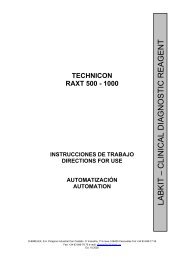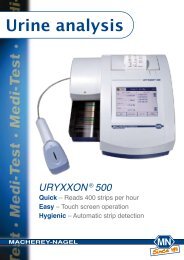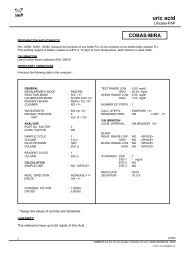HBsAg 2-steps - Agentúra Harmony vos
HBsAg 2-steps - Agentúra Harmony vos
HBsAg 2-steps - Agentúra Harmony vos
- No tags were found...
You also want an ePaper? Increase the reach of your titles
YUMPU automatically turns print PDFs into web optimized ePapers that Google loves.
Doc.: INS DAG.CE Page 1 of 7 Rev.: 1 09/2003HDV AgEnzyme Immunoassay for thedetermination of Hepatitis Delta Virusin human serum and plasma- for “in vitro” diagnostic use only -DIA.PRODiagnostic Bioprobes SrlVia Columella n° 3120128 Milano - ItalyPhone +39 02 27007161Fax +39 02 26007726e-mail: diapro@tin.itREF DAG.CE96 Tests
Doc.: INS DAG.CE Page 2 of 7 Rev.: 1 09/2003HDV AgA. INTENDED USEThird generation Enzyme ImmunoAssay (ELISA) for thedetermination of Hepatitis Delta Virus or HDV in humanplasma and sera. The kit is intended for the follow-up of HDVinfected patients.For “in vitro” diagnostic use only.B. INTRODUCTIONThe Hepatitis Delta Virus or HDV is a RNA defective viruscomposed of a core presenting the delta-specific antigen,encapsulated by <strong>HBsAg</strong>, that requires the helper function ofHBV to support its replication.Infection by HDV occurs in the presence of acute or chronicHBV infection. When acute delta and acute HBV simultaneouslyoccur, the illness becomes severe and clinical and biochemicalfeatures may be indistinguishable from those of HBV infectionalone.In contrast, a patient with chronic HBV infection can supportHDV replication indefinitely, usually with a less severe illnessappearing as a clinical exacerbation.The determination of HDV specific serological markers (HDVAg, HDV IgM and HDV IgG) represents in these cases animportant tool to the clinician for the classification of theetiological agent, for the follow up of infected patients and theirtreatment.The detection of HDV antibodies allows the classification of theillness and the monitoring of the seroconversion event.4. Calibrator: CAL ….n° 1 vial. Lyophilised calibrator. To be dissolved with EIA gradewater as reported in the label. Contains bovine serum proteins,non infectious recombinant low titer HDV antigen, 0.02%gentamicine sulphate and 0.1% Kathon GC as preservatives.Note: The volume necessary to dissolve the content of thevial may vary from lot to lot. Please use the right volumereported on the label .5. Wash buffer concentrate: WASHBUF 20X1x60ml/bottle. 20x concentrated solution.Once diluted, the wash solution contains 10 mM phosphatebuffer pH 7.0+/-0.2, 0.05% Tween 20 and 0.1% Kathon GC.6. Enzyme conjugate: CONJ1x16ml/vial. Ready to use and color coded regent. ContainsHorseradish peroxidase conjugated polyclonal antibody to HDVantigen, 10 mM Tris buffer pH 6.8+/-0.1, 5% BSA, 1% normalmouse serum, 0.1% Kathon GC and 0.02% gentamicinesulphate as preservatives.The component is red color coded.7. Chromogen/Substrate: SUBS TMB1x16ml/vial. It contains a 50 mM citrate-phosphate bufferedsolution at pH 3.5-3.8, 4% DMSO, 0.03% tetra-methyl-benzidineor TMB and 0.02% hydrogen peroxide of H2O2.Note: To be stored protected from light as sensitive tostrong illumination.8. Specimen Diluent: DILSPE1x16ml. Contains a solution of 6% NP40, 0.1% Kathon GC and0.09% sodium azide as preservatives in 10 mM phosphatebuffer pH 7.4+/-0.1.C. PRINCIPLE OF THE TEST 9. Sulphuric Acid: H2SO4 O.3 MHDV Ag, if present in the sample, is captured by a specific 1x15ml/vial. It contains 0.3 M H2SO4 solution.monoclonal antibody, in the 1 st incubation. A detergent is added Attention: Irritant (Xi R36/38; S2/26/30)to the sample in order to dissolve the specific antigen from HDVparticles.10. Plate sealers: n° 2In the 2 ndincubation, after washing, a tracer, composed of asecond anti HDV Ag antibody, labeled with peroxidase (HRP), is 11. Instructions for Use: n° 1added to the microplate and binds to the captured HDV Ag.The concentration of the bound enzyme on the solid phase isproportional to the amount of HDV Ag in the sample and itsactivity is detected by adding the chromogen/substrate in the 3 rdincubation.The presence of HDV Ag in the sample is determined by meansof a cut-off value that allows for the semi quantitative detectionof the antigen.D. COMPONENTSIt contains reagents to perform 96 tests.1. Microplate: MICROPLATEn° 1 microplate12 strips x 8 breakable wells coated with a mouse monoclonalantibody specific to HDV antigen and sealed into a bag withdesiccant.2. Negative Control: CONTROL -1x2.0ml/vial. Ready to use control. It contains 5% goat serumalbumin, 100 mM Tris-HCl buffer pH 7.4+/-0.1, 0.09% Na-azideand 0.1% Kathon GC as preservatives.The negative control is color coded pale yellow.3. Positive Control: CONTROL +1x2.0ml/vial. Lyophilized control to be dissolved with 2 mlbidistilled water. It contains 5% goat serum albumin, high titernon infectious recombinant HDV antigen, 25 mM Tris-HCl bufferpH 7.4+/-0.1, 0.02% gentamicine sulphate and 0.1% Kathon GCas preservatives.E. MATERIALS REQUIRED BUT NOT PROVIDED1. Calibrated Micropipettes (150ul, 100ul and 50ul) anddisposable plastic tips.2. EIA grade water (double distilled or deionised, charcoaltreated to remove oxidizing chemicals used asdisinfectants).3. Timer with 60 minute range or higher.4. Absorbent paper tissues.5. Calibrated ELISA microplate thermostatic incubator (dry orwet), capable to provide shaking at 1300 rpm+/-150, set at+37°C.6. Calibrated ELISA microwell reader with 450nm (reading)and possibly with 620-630nm (blanking) filters.7. Calibrated ELISA microplate washer.8. Vortex or similar mixing tools.F. WARNINGS AND PRECAUTIONS1. The kit has to be used by skilled and properly trainedtechnical personnel only, under the supervision of a medicaldoctor responsible of the laboratory.2. All the personnel involved in performing the assay have towear protective laboratory clothes, talc-free gloves and glasses.The use of any sharp (needles) or cutting (blades) devicesshould be avoided. All the personnel involved should be trainedin biosafety procedures, as recommended by the Center forDisease Control, Atlanta, U.S. and reported in the National
Doc.: INS DAG.CE Page 3 of 7 Rev.: 1 09/2003Institute of Health’s publication: “Biosafety in Microbiological andBiomedical Laboratories”, ed. 1984.3. All the personnel involved in sample handling should bevaccinated for HBV and HAV, for which vaccines are available,safe and effective.4. The laboratory environment should be controlled so as toavoid contaminants such as dust or air-born microbial agents,when opening kit vials and microplates and when performing thetest. Protect the Chromogen (TMB) from strong light and avoidvibration of the bench surface where the test is undertaken.5. Upon receipt, store the kit at 2..8°C into a temperaturecontrolled refrigerator or cold room.6. Do not interchange components between different lots ofthe kits. It is recommended that components between two kitsof the same lot should not be interchanged.7. Check that the reagents are clear and do not containvisible heavy particles or aggregates. If not, advise thelaboratory supervisor to initiate the necessary procedures for kitreplacement.8. Avoid cross-contamination between serum/plasmasamples by using disposable tips and changing them after eachsample.9. Avoid cross-contamination between kit reagents by usingdisposable tips and changing them between the use of eachone.10. Do not use the kit after the expiration date stated on theexternal container and internal (vials) labels. A study conductedon an opened kit has not pointed out any relevant loss of activityup to 6 re-use of the device and up to 3 months.11. Treat all specimens as potentially infective. All humanserum specimens should be handled at Biosafety Level 2, asrecommended by the Center for Disease Control, Atlanta, U.S.in compliance with what reported in the Institutes of Health’spublication: “Biosafety in Microbiological and BiomedicalLaboratories”, ed. 1984.12. The use of disposable plastic-ware is recommended in thepreparation of the liquid components or in transferringcomponents into automated workstations, in order to avoidcross contamination.13. Waste produced during the use of the kit has to bediscarded in compliance with national directives and lawsconcerning laboratory waste of chemical and biologicalsubstances. In particular, liquid waste generated from thewashing procedure, from residuals of controls and from sampleshas to be treated as potentially infective material and inactivatedbefore waste. Suggested procedures of inactivation aretreatment with a 10% final concentration of household bleach for16-18 hrs or heat inactivation by autoclave at 121°C for 20 min..14. Accidental spills from samples and operations have to beadsorbed with paper tissues soaked with household bleach andthen with water. Tissues should then be discarded in propercontainers designated for laboratory/hospital waste.15. The Sulphuric Acid is an irritant. In case of spills, wash thesurface with plenty of water16. Other waste materials generated from the use of the kit(example: tips used for samples and controls, used microplates)should be handled as potentially infective and disposedaccording to national directives and laws concerning laboratorywastes.G. SPECIMEN: PREPARATION AND WARNINGS1. Blood is drawn aseptically by venepuncture and plasma orserum is prepared using standard techniques of preparation ofsamples for clinical laboratory analysis. No influence has beenobserved in the preparation of the sample with citrate, EDTAand heparin.2. Avoid any addition of preservatives to samples; especiallysodium azide as this chemical would affect the enzymaticactivity of the conjugate, generating false negative results.3. Samples have to be clearly identified with codes or names inorder to avoid misinterpretation of results.4. Haemolysed (red) and visibly hyperlipemic (“milky”) sampleshave to be discarded as they could generate false results.Samples containing residues of fibrin or heavy particles ormicrobial filaments and bodies should be discarded as theycould give rise to false results.5. Sera and plasma can be stored at +2°..8°C for up to five daysafter collection. For longer storage periods, samples can bestored frozen at –20°C for several months. Any frozen samplesshould not be frozen/thawed more than once as this maygenerate particles that could affect the test result.6. If particles are present, centrifuge at 2.000 rpm for 20 min orfilter using 0.2-0.8u filters to clean up the sample for testing.H. PREPARATION OF COMPONENTS AND WARNINGSA study conducted on an opened kit has not pointed out anyrelevant loss of activity up to 6 re-uses of the device and up to 3months.Microplates:Allow the microplate to reach room temperature (about 1 hr)before opening the container. Check that the desiccant hasnot turned dark green, indicating a defect in manufacturing.In this case, call Dia.Pro’s customer service.Unused strips have to be placed back inside the aluminumpouch, with the desiccant supplied, firmly zipped and stored at+2°..8°C. After first opening, remaining strips are stable until thehumidity indicator inside the desiccant bag turns from yellow togreen.Negative Control:Ready to use. Mix well on vortex before use.Positive Control:Dissolve with 2 ml ELISA grade water and mix well on vortexbefore use. The positive control does not contain any infectiveHDV as it is composed of recombinant synthetic HDV.Note: The dissolved control is not stable. To be stored frozen inaliquots at –20°C.Calibrator:Add the volume of ELISA grade water, reported on the label, tothe lyophilised powder; let fully dissolve and then gently mix onvortex.Note: The dissolved Calibrator is not stable. To be stored frozenin aliquots at –20°C.Wash buffer concentrate:The whole content of the concentrated solution has to bediluted 20x with bidistilled water and mixed gently end-over-endbefore use. During preparation avoid foaming as the presenceof bubbles could impact on the efficiency of the washing cycles.Note: Once diluted, the wash solution is stable for 1 week at+2..8° C.Enzyme Conjugate:Ready to use. Mix well on vortex before use.Avoid contamination of the liquid with oxidizing chemicals, dustor microbes. If this component has to be transferred, use onlyplastic, and if possible, sterile disposable containers.Chromogen/Substrate:Ready to use. Mix well on vortex before use.Avoid contamination of the liquid with oxidizing chemicals, airdrivendust or microbes. Do not expose to strong light, oxidizingagents and metallic surfaces.If this component has to be transferred use only plastic, and ifpossible, sterile disposable containerSpecimen DiluentReady to use reagent. Mix gently and avoid foaming.
Doc.: INS DAG.CE Page 4 of 7 Rev.: 1 09/2003Sulphuric Acid:L. PRE ASSAY CONTROLS AND OPERATIONSReady to use. Mix well on vortex before use.1. Check the expiration date of the kit printed on the externalAttention: Irritant (Xi R36/38; S2/26/30)label (primary container). Do not use if expired.Legenda: R 36/38 = Irritating to eyes and skin. 2. Check that the liquid components are not contaminated byS 2/26/30 = In case of contact with eyes, rinse immediately with visible particles or aggregates. Check that theplenty of water and seek medical advice.Chromogen/Substrate is colourless or pale blue byaspirating a small volume of it with a sterile plastic pipette.Check that no breakage occurred in transportation and nospillage of liquid is present inside the box (primaryI. INSTRUMENTS AND TOOLS USED IN COMBINATIONcontainer). Check that the aluminium pouch, containing themicroplate, is not punctured or damaged.WITH THE KIT1. Micropipettes have to be calibrated to deliver the correctvolume required by the assay and must be submitted toregular decontamination (household alcohol, 10% solutionof bleach, hospital grade disinfectants) of those parts thatcould accidentally come in contact with the sample. Theyshould also be regularly maintained. Decontamination ofspills or residues of kit components should also be carriedout regularly.2. The ELISA incubator has to be set at +37°C (tolerance of +/-0.5°C) and regularly checked to ensure the correcttemperature is maintained. Both dry incubators and waterbaths are suitable for the incubations, provided that theinstrument is validated for the incubation of ELISA tests.3. The ELISA washer is extremely important to the overallperformances of the assay. The washer must be carefullyvalidated and correctly optimized using the kit controls andreference panels, before using the kit for routine laboratorytests. 4-5 washing cycles (aspiration + dispensation of350ul/well of washing solution = 1 cycle) are sufficient toensure that the assay performs as expected. A soaking timeof 20-30 seconds between cycles is suggested. In order toset correctly their number, it is recommended to run anassay with the kit controls and well characterized negativeand positive reference samples, and check to match thevalues reported below in the sections “Validation of Test”and “Assay Performances”. Regular calibration of thevolumes delivered by, and maintenance (decontaminationand cleaning of needles) of the washer has to be carried outaccording to the instructions of the manufacturer.4. Incubation times have a tolerance of +5%.5. The ELISA reader has to be equipped with a reading filter of450nm and ideally with a second filter (620-630nm) forblanking purposes Blanking is carried out on the wellidentified in the section “Assay Procedure”. The opticalsystem of the reader has to be calibrated regularly to ensurethe correct optical density is measured. It should beregularly maintained according to the manufacturer ‘sinstructions.6. When using an ELISA automated work station, all critical<strong>steps</strong> (dispensation, incubation, washing, reading, datahandling) have to be carefully set, calibrated, controlled andregularly serviced in order to match the values reported inthe sections “Validation of Test” and “Assay Performances”.The assay protocol has to be installed in the operatingsystem of the unit and validated as for the washer and thereader. In addition, the liquid handling part of the station(dispensation and washing) has to be validated andcorrectly set. Particular attention must be paid to avoid carryover by the needles used for dispensing and for washing.This must be studied and controlled to minimize thepossibility of contamination of adjacent wells. The use ofELISA automated work stations is recommended when thenumber of samples to be tested exceed 20-30 units per run.7. Dia.Pro’s customer service offers support to the user in thesetting and checking of instruments used in combinationwith the kit, in order to assure compliance with therequirements described. Support is also provided for theinstallation of new instruments to be used with the kit.3. Dilute all the content of the 20x concentrated Wash Solutionas described above.4. Dissolve the Positive Control and the Calibrator asdescribed above and gently mix.5. Allow all the other components to reach room temperature(about 1 hr) and then mix gently on vortex all liquidreagents.6. Set the ELISA incubator at +37°C and prepare the ELISAwasher by priming with the diluted washing solution,according to the manufacturers instructions. Set the rightnumber of washing cycles as found in the validation of theinstrument for its use with the kit.7. Check that the ELISA reader is turned on or ensure it will beturned on at least 20 minutes before reading.8. If using an automated work station, turn on, check settingsand be sure to use the right assay protocol.9. Check that the micropipettes are set to the required volume.10. Check that all the other equipment is available and readyto use.11. In case of problems, do not proceed further with the test andadvise the supervisor.M. ASSAY PROCEDUREThe assay has to be performed according to the proceduregiven below, taking care to maintain the same incubation timefor all the samples being tested.1. Place the required number of strips in the plastic holder.Carefully identify the wells for controls, calibrator andsamples.2. Leave the A1 well empty for blanking purposes.3. Pipette 100 µl of the Negative Control in triplicate, 100 ul ofthe Calibrator in duplicate and then 100 ul of the PositiveControl in single followed by 100 ul of samples.4. Check for the presence of samples in wells by naked eye(there is a marked colour difference between empty and fullwells) or by reading at 450/620nm. (samples show ODvalues higher than 0.100).5. Then add 100 µl Specimen Diluent to all the wells, exceptfor A1.6. Finally incubate the microplate for 120 min at +37°C.Important note: Strips have to be sealed with the adhesivesealing foil, only when the test is performed manually. Do notcover strips when using ELISA automatic instruments.7. When the first incubation is over, wash the microwells aspreviously described (section I.3)8. Dispense 100 ul Enzyme Conjugate in all wells, except forA1, used for blanking operations.Important note: Be careful not to touch the inner surface of thewell with the pipette tip. Contamination might occur.9. Following addition of the conjugate, check that the colour ofwells have changed to red and then incubate the microplatefor 60 min at +37°C.10. When the second incubation is finished, wash themicrowells as previously described (section I.3)
Doc.: INS DAG.CE Page 5 of 7 Rev.: 1 09/200311. Pipette then 100µl Chromogen/Substrate into all the wells,A1 included.Important note: Do not expose to strong direct light as a highbackground might be generated.O. INTERNAL QUALITY CONTROLA check is performed on the controls/calibrator any time the kitis used in order to verify whether the expected OD450nm orS/Co values have been matched in the analysis.Ensure that the following results are met:12. Incubate the microplate protected from light at roomtemperature (18-24°C) for 20 min. Wells dispensed withpositive control and positive samples will turn from clear toblue.13. Pipette 100 µl Sulphuric Acid into all the wells using thesame pipetting sequence as in step 11 to stop theenzymatic reaction. Addition of the stop solution will turn thepositive control and positive samples from blue to yellow.14. Measure the colour intensity of the solution in each well, asdescribed in section I.5 using a 450nm filter (reading) and ifpossible a 620-630nm filter (background subtraction),blanking the instrument on A1.Important notes:1. If the second filter is not available, ensure that no fingerprints are present on the bottom of the microwell beforereading at 450nm. Finger prints could generate falsepositive results on reading.2. Reading should ideally be performed immediately after theaddition of the Stop Solution but definitely no longer than 20minutes afterwards. Some self oxidation of the chromogencan occur leading to a higher background.N. ASSAY SCHEMEControls & CalibratorSamples100ul100ulSpecimen Diluent100ul1 st incubation 120 minTemperature+37°CWashing <strong>steps</strong> n° 4-5Enzyme Conjugate100ul2 nd incubation 60 minTemperature+37°CWashing <strong>steps</strong> n° 4-5Chromogen/Substrate100ul3 rd incubation 20 minTemperatureroomSulphuric Acid100 ulReading OD450nmAn example of dispensation scheme is reported below:Microplate1 2 3 4 5 6 7 8 9 10 11 12A BLK S2B NC S3C NC S4D NC S5E CAL S6F CAL S7G PC S8H S1 S9ParameterBlank wellNegative Control(NC)Requirements< 0.100 OD450nm value< 0.100 mean OD450nm value afterblankingcoefficient of variation < 30%Calibrator S/Co > 1Positive Control > 1.000 OD450nm valueIf the results of the test match the requirements stated above,proceed to the next section.If they do not, do not proceed any further and perform thefollowing checks:ProblemBlank well> 0.100 OD450nmNegative Control(NC)> 0.100 OD450nmafter blankingcoefficient ofvariation > 30%CalibratorS/Co < 1Positive Control< 1.000 OD450nmCheck1. that the Chromogen/Substrate solution hasnot become contaminated during the assay1. that the washing procedure and the washersettings are as validated in the pre qualificationstudy;2. that the proper washing solution has beenused and the washer has been primed with itbefore use;3. that no mistake has been done in the assayprocedure (dispensation of positive controlinstead of negative control);4. that no contamination of the negative controlor of the wells where the control was dispensedhas occurred due to positive samples, to spillsor to the enzyme conjugate;5. that micropipettes have not becomecontaminated with positive samples or with theenzyme conjugate;6. that the washer needles are not blocked orpartially obstructed.1. that the procedure has been correctlyperformed;2. that no mistake has occurred during itsdistribution (ex.: dispensation of negativecontrol instead);3. that the washing procedure and the washersettings are as validated in the pre qualificationstudy;4. that no external contamination of thecalibrator has occurred.1. that the procedure has been correctlyperformed;2. that no mistake has occurred during thedistribution of the control (dispensation ofnegative control instead of positive control);3. that the washing procedure and the washersettings are as validated in the pre qualificationstudy;4. that no external contamination of the positivecontrol has occurred.If any of the above problems have occurred, report the problemto the supervisor for further actions.P. CALCULATION OF THE CUT-OFFThe test results are calculated by means of a cut-off valuedetermined with the following formula:Cut-Off = NC mean OD450nm + 0.100Legenda: BLK = Blank NC = Negative ControlCAL = Calibrator PC = Positive Control S = Sample The value found for the test is used for the interpretation ofresults as described in the next paragraph.
Doc.: INS DAG.CE Page 6 of 7 Rev.: 1 09/2003Important note: When the calculation of results is performed bythe operating system of an ELISA automated work station, ensure that the proper formulation is used to calculate the cut-offvalue and generate the correct interpretation of results.Q. INTERPRETATION OF RESULTSTest results are interpreted as a ratio of the sample OD450nmand the Cut-Off value (or S/Co) according to the following table:S/CoInterpretation< 0.9 Negative0.9 – 1.1 Equivocal> 1.1 PositiveA negative result indicates that the patient is not infected byHDV (acute phase).Any patient showing an equivocal result should be retested on asecond sample taken 1-2 weeks after the initial sample.A positive result is indicative of an ongoing HDV infection andtherefore the patient should be treated accordingly.Important notes:1. Interpretation of results should be done under thesupervision of the laboratory supervisor to reduce the risk ofjudgement errors and misinterpretations.2. Any positive result should be confirmed by testing thepatient for the other HDV markers, before a diagnosis ofviral hepatitis is confirmed.3. When test results are transmitted from the laboratory toanother facility, attention must be paid to avoid erroneousdata transfer.4. Diagnosis of viral hepatitis infection has to be taken by andreleased to the patient by a suitably qualified medicaldoctor.An example of calculation is reported below.The following data must not be used instead or real figuresobtained by the user.Negative Control: 0.020 – 0.030 – 0.025 OD450nmMean Value: 0.025 OD450nmLower than 0.100 – AcceptedPositive Control: 2.489 OD450nmHigher than 1.000 – AcceptedCut-Off = 0.025+0.100 = 0.125Calibrator: 0.280 - 0.290 OD450nmMean value: 0.285 OD450nm S/Co = 2.3S/Co higher than 1 – AcceptedSample 1: 0.030 OD450nmSample 2: 1.800 OD450nmSample 1 S/Co < 0.9 = negativeSample 2 S/Co > 1.1 = positiveR. PERFORMANCE CHARACTERISTICSEvaluation of Performances has been conducted in accordanceto what reported in the Common Technical Specifications orCTS (art. 5, Chapter 3 of IVD Directive 98/79/EC).1. Limit of detectionNo international standard for HDV antigen detection is availableat the moment. An Internal Gold Standard (or IGS), derived froma patient in the acute phase of the infection, has been defined inorder to provide the device with a constant and optimalsensitivity.The limit of detection of the assay has been therefore calculatedby comparison with a commercial European kit.A limiting dilution curve was prepared in negative plasma.Results of Quality Control are given in the following table:Internal Gold Standard (IGS)IGS Lot # 1102 Lot # 0103 Lot # 0403 DiaSorindilution OD450n S/C OD450n S/C OD450n S/C S/Com o m o m o2 K 0.486 4.4 0.539 4.7 0.504 4.7 4.54 K 0.266 2.4 0.289 2.5 0.304 2.8 2.68 K 0.151 1.4 0.144 1.3 0.163 1.5 1.316 K 0.071 0.6 0.078 0.7 0.081 0.8 0.7Neg.Control0.011 ///// 0.015 ///// 0.008 ///// /////2. Clinical Sensitivity and Specificity:The clinical sensitivity has been tested on panels of samplesclassified positive by a reference European kit.Positive samples were collected from patients undergoing acuteHDV infection.The clinical specificity has been determined on panels of morethan 250 negative samples from normal individuals and blooddonors, classified negative with the reference kit.Both plasma, derived with different standard techniques ofpreparation (citrate, EDTA and heparin), and sera have beenused to determine the specificity.No false reactivity due to the method of specimen preparationhas been observed.Frozen specimens have also been tested to check whethersamples freezing interferes with the performance of the test.No interference was observed on clean and particle freesamples.Samples derived from patients with different viral (HCV, HAV)and non viral pathologies of the liver that may interfere with thetest were examined. No cross reaction were observed.The Performance Evaluation study conducted in a qualifiedexternal reference center on more than 300 samples hasprovided the following values :Sensitivity > 98 %Specificity > 98 %3. Precision:It has been calculated on three samples examined in replicatesin different runs.The mean values obtained from a study conducted on threesamples of different HDV Antigen reactivity, examined in 16replicates in three separate runs is reported below:DAG.CE: lot # 1102Negative Control (N = 16)Mean values 1st run 2nd run 3 rd run AveragevalueOD 450nm 0.021 0.020 0.019 0.020Std.Deviation 0.004 0.005 0.004 0.004CV % 17.7 22.7 19.3 19.9IGS at 8 K (N = 16)Mean values 1st run 2nd run 3 rd run AveragevalueOD 450nm 0.167 0.166 0.169 0.167Std.Deviation 0.006 0.008 0.005 0.006
Doc.: INS DAG.CE Page 7 of 7 Rev.: 1 09/2003CV % 3.9 4.6 3.1 3.9S/Co 1.3 1.4 1.4 1.4IGS at 0.5 K (N = 16)Mean values 1st run 2nd run 3 rd run AveragevalueOD 450nm 2.416 2.404 2.372 2.397Std.Deviation 0.150 0.143 0.130 0.141CV % 6.2 5.9 5.5 5.9S/Co 19.9 20.0 19.9 19.9S. LIMITATIONSFalse positivity has been assessed as less than 2 % of thenormal population, mostly due to high titers of Heterophilic AntiMouse Antibodies (HAMA).Frozen samples containing fibrin particles or aggregates maygenerate false positive results.DAG.CE: lot # 0103Negative Control (N = 16)Mean values 1st run 2nd run 3 rd run AveragevalueOD 450nm 0.019 0.020 0.018 0.019Std.Deviation 0.003 0.004 0.003 0.003CV % 17.6 19.4 17.7 18.2IGS at 8 K (N = 16)Mean values 1st run 2nd run 3 rd run AveragevalueOD 450nm 0.180 0.180 0.181 0.180Std.Deviation 0.007 0.008 0.008 0.008CV % 3.8 4.5 4.4 4.3S/Co 1.5 1.5 1.5 1.5IGS at 0.5 K (N = 16)Mean values 1st run 2nd run 3 rd run AveragevalueOD 450nm 2.415 2.453 2.437 2.435Std.Deviation 0.135 0.131 0.153 0.140CV % 5.6 5.3 6.3 5.7S/Co 20.3 20.4 20.7 20.5REFERENCES1. Engvall E. and Perlmann P.. J.Immunochemistry 8: 871-874, 19712. Engvall E. and Perlmann P.. J.Immunol.. 109: 129-135,19713. Chaggar K. Et al.. Journal of Virological Methods. 32: 193-199, 19914. Lazinski D.W. et al.. Journal of Virol.. 67: 2672-2680, 19935. Govindarajan S. et al.. Microbiol. And Immunol.. 95: 140-141, 19906. Shattock A.G. et al.. J.Clin.Microbiol.. 29: 1873-1876, 19917. Forbes B.A. et al.. Clin.Microbiol.News.. 13: 52-54, 19918. Bergmann, K. et al. J.Immunol. 143:3714-3721, 19899. Bergmann, K. et al. J.Infect.Dis. 154:702-706, 198610. Buti, M. et al. Hepatology 8:1125-1129, 198811. Rizzetto, M. Hepatology 3729-737, 198312. Rizzetto, M. et al. Proc.Natl.Acad.Sci. USA 77:6124-6128,198013. Dubois, F. et al. J.Clin.Microbiol. 26:1339-1342, 198814. Wang, K. et al. Nature 323:508-514, 198615. Grebenchtchikiov N. et al.. J.Immunol. Methods,15(2) :219-231, 200216. Schrijver RS and Kramps JA, Rev.Sci.Tech. 17(2):550-561, 1998DAG.CE: lot #0403Negative Control (N = 16)Mean values 1st run 2nd run 3 rd run AveragevalueOD 450nm 0.015 0.016 0.015 0.015Std.Deviation 0.003 0.003 0.003 0.003CV % 17.7 18.8 19.3 18.6IGS at 8 K (N = 16)Mean values 1st run 2nd run 3 rd run AveragevalueOD 450nm 0.170 0.169 0.172 0.170Std.Deviation 0.008 0.008 0.008 0.008CV % 4.8 4.7 4.5 4.7S/Co 1.5 1.5 1.5 1.5IGS at 0.5 K (N = 16)Mean values 1st run 2nd run 3 rd run AveragevalueOD 450nm 2.378 2.370 2.393 2.380Std.Deviation 0.103 0.094 0.099 0.099CV % 4.4 4.0 4.1 4.2S/Co 20.9 20.6 21.0 20.8This product has been manufactured by Dia. Pro s.r.l. underthe controls established by a full quality managementsystem that meets the requirementsof ISO 13485 as declared by the EC Notified Body n° 0318in certificate n° 2003 12 2388 ENProduced byDia.Pro. Diagnostic Bioprobes Srl.via Columella n° 31 – Milano - ItalyDoc.: INS DAG.CE Rev.: 1 09/2003|0318The variability shown in the tables did not result in samplemisclassification.



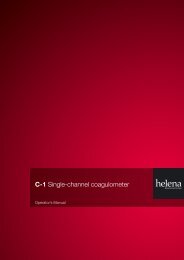
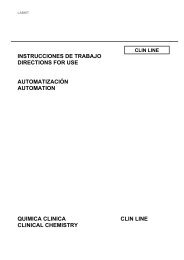
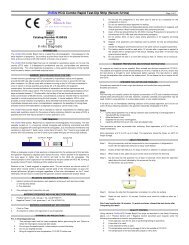
![[APTT-SiL Plus]. - Agentúra Harmony vos](https://img.yumpu.com/50471461/1/184x260/aptt-sil-plus-agentara-harmony-vos.jpg?quality=85)


![[SAS-1 urine analysis]. - Agentúra Harmony vos](https://img.yumpu.com/47529787/1/185x260/sas-1-urine-analysis-agentara-harmony-vos.jpg?quality=85)


![[SAS-MX Acid Hb]. - Agentúra Harmony vos](https://img.yumpu.com/46129828/1/185x260/sas-mx-acid-hb-agentara-harmony-vos.jpg?quality=85)

